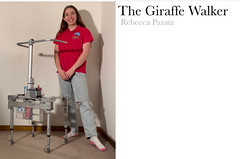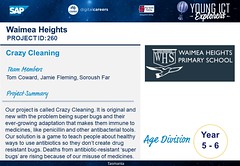Sustainability Award
Clean Water Warriors
Ronan Power, Alfred Newberry
St Joseph’s Bardon
The Ocean clean up inspired us because of how much rubbish is in the ocean. They use machines like a conveyer belt to collect water and filter rubbish out of it.
We are trying to solve the problem of getting clean water to remote or poor places. Whilst researching we found out about Papua New Guinea. It is ranked the second country in the world without clean water. We realised places in Papua New Guinea didn’t have enough clean water near them to survive.
Our project is an industrial sized LifeStraw. Water from the ocean gets collected and filtered by the LifeStraw. A pipe then leads to a treatment plant dam, then it goes through the pipe to the village and fills a well for the people to access.
We chose our project by deciding on the most common problem that we know is water pollution. Around 800 million people don’t have basic access to clean water. Those who live in countries without clean water can get sick, struggle to attend school and they will have to make trips to distant water sources, and battle poverty. Clean Water and Sanitation is one of the Global Goals.
We created a life sized model of our project in Minecraft Education. We build a tube that collects the water and puts it into our LifeStraw. From the LifeStraw if flows into the dam. The water flows through the pipe into the well. we used a sticky piston in our Minecraft model which has a important job, it pushes the water through the pipe which flows into a well.
The problems we encountered whilst making our prototype were figuring out how to take filter water to a village or city. We struggled to work out how to build a machine that would manoeuvre over the water and flow water into the well. We started using Spike but didn’t have enough pieces to make a physical model. We ended up using Minecraft because it has infinite blocks when you use it and we needed a lot of blocks to build the well and the LifeStraw.
Next time we would choose a different project, because we found it difficult to access technology which limited our range of things, we could build with to solve our problem of water pollution. However, we think our project has achieved what we wanted to achieve. As we got to build a virtual prototype of our model to solve Papua New Guinea’s water crisis.



